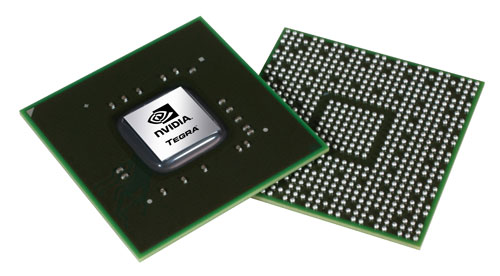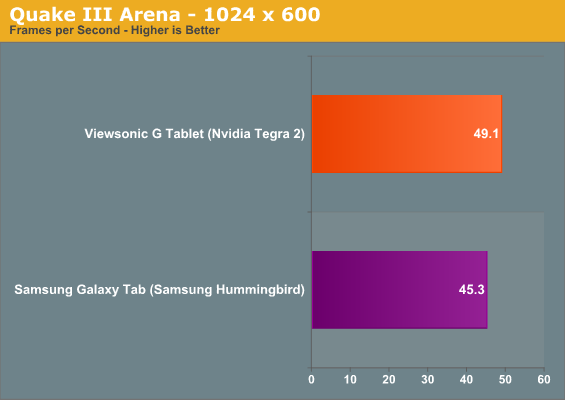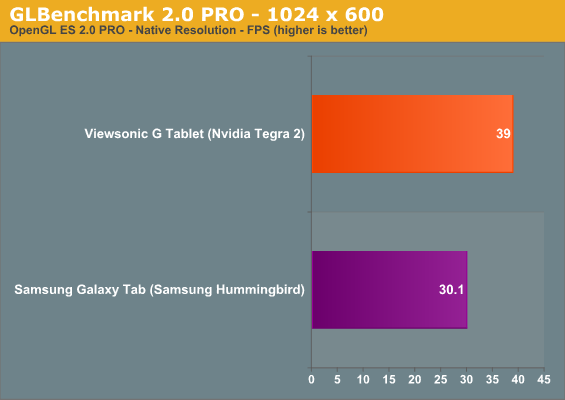Nvidia Tegra 2 - Graphics Performance Update
by Vivek Gowri on December 20, 2010 11:00 PM EST

So I have a confession to make. Before we posted our Tegra 2 performance preview, I ran the Quake 3 demo on the Viewsonic G Tablet and the Samsung Galaxy Tab three times each. I ended up with 49.0, 48.2 and 49.9 fps on the Viewsonic, and 31.9, 32.2, and 32.1 fps on the Galaxy Tab. Run the averages, and you get 49.1 fps for the Viewsonic and 32.1 fps for the Galaxy. Based on some input from Imagination and other Galaxy Tab users, we decided to retest the Galaxy Tab, since our results were a good bit lower than what they were reporting.
And on re-running the Quake 3 benchmark, I got results in the 44.9 - 46.0 range. I ran it over 50 times trying to replicate the previous scores, but under no conditions (settings, background applications, etc) could I get anywhere near my previous result. I know for a fact that the settings were all correct and that there were no previously running applications, so I really have no idea why I got a framerate that low, much less why it was repeatable.
In addition to retesting Quake 3 on the Galaxy Tab, I also ran both slates through GLBenchmark 2.0, which we recently added to our benchmark suite. The combination of the two gave me enough reason to write up an update to our Tegra 2 performance preview from two weeks ago. I was also planning to compare Quadrant’s 3D graphics score, but I was unable to get the SlideME store working on the Viewsonic to download Quadrant Professional.
So, let’s get to it. With the revised Quake 3 benchmarks, Tegra 2 has a slight 10% lead over the SGX 540, bringing it more in line with what we expected. Looking at our GLBenchmark 2.0 results, we can see that Tegra 2 has the lead here as well, though by a slightly larger margin. In GLBenchmark Pro, the Tegra 2 has a 30% lead over the Hummingbird, while in the more-demanding Egypt benchmark, the gap shrinks to 20.4%.



So while the performance difference isn’t nearly as dramatic as we originally thought, most of what we said before still holds true. It looks like Tegra 2 has the potential to be the best SoC for Android gaming, making it a really attractive platform for tablets. With all the rumours flying around about Google making Tegra 2 the reference platform for Honeycomb-based tablets, apparently we’re not the only ones who think so. The question is how well will it handle existing 3D content that's likely optimized for Qualcomm and Imagination Technologies GPUs.
We’ll take a more in-depth look at Tegra 2’s performance as well as power consumption in our full review later this month, and hopefully by that time we can give you the Quadrant benchmarks as well. But for now, we can say that Tegra 2 is the most powerful SoC on the market at present and makes for a very capable tablet platform.










27 Comments
View All Comments
xodius80 - Tuesday, December 21, 2010 - link
i thought i mention this ( i would in the forums but somehow i can post here but cant log in into the forums) i wount post this information but i think this has gone too far in terms of abuse in some part from this mayor website, i would like to share it with you all, and let this be an example of what has NOT to be done in a mayor tech or any website:http://forums.guru3d.com/showthread.php?t=334905&a...
i find it sad, how a person just because he posts there something thats against the website or does not agree about the way the website informs the reviews, gets harrased and bashed by the comunity forum, and worse than that, the staff and owner of the site encourages this kind of behaviour, its a shame.
Shadowmaster625 - Tuesday, December 21, 2010 - link
"so I really have no idea why I got a framerate that low, much less why it was repeatable"I've seen this sort of thing before. It is called "SOICANHASFREESTUFFFROMVNVIDIA"
Demon-Xanth - Tuesday, December 21, 2010 - link
http://www.anandtech.com/show/391/16They're on par with the 450K6-2 system in the Geforce256 review. And these are phones/tablets. Ain't technology grand?
tipoo - Wednesday, December 22, 2010 - link
Hah, that is interesting, thanks for pointing it out.GnillGnoll - Wednesday, December 22, 2010 - link
Are these benchmarks running at 16 or 32 bit color depth? I'm also wondering what the Z buffer depth is, as I've seen the Egypt benchmark running on a Toshiba AC-100 (a Tegra 2 device) using a 16-bit Z buffer and there was pretty bad Z fighting visible.TareX - Wednesday, December 22, 2010 - link
The main appeal Tegra 2 possesses, is not its power, but the fact it's an ultra low power. NVIDIA have done a feat making its GPU draw a whole lot less power than other GPUs. It's why Samsung dropped its very own -much hyped, Orion SOC.A4i - Monday, December 27, 2010 - link
Well, T2 is on TSMC plain silicon tech process. Nothing magical there. It is not HKMG or SOI, so no low power benefit at all. Maybe next Tegra on 28nm? Who knows. But dual core cpu versus single core& old gen? Dual core allways wins.